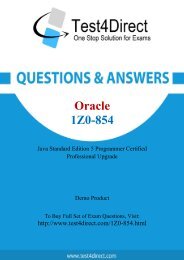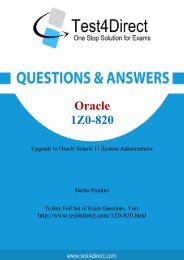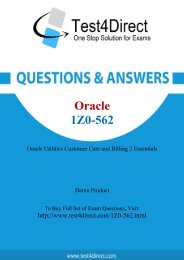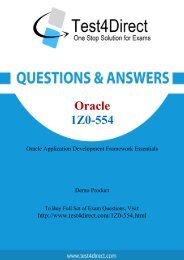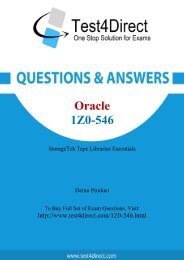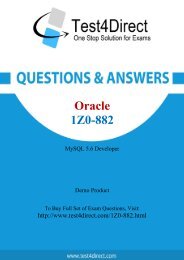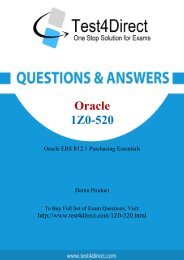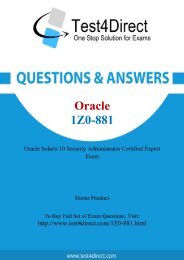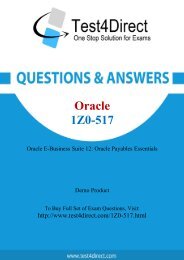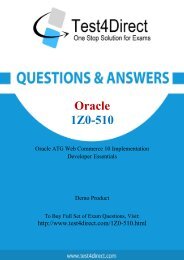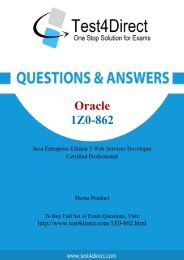Up-to-Date 1Z0-067 Exam BrainDumps
Test4Direct provides latest PDF questions of Oracle 1Z0-067 exam. You have an opportunity to pass the Oracle 1Z0-067 exam in one go. Test4Direct is most accurate source to prepare Oracle 1Z0-067 exam as your success will become site’s responsibility after purchasing 1Z0-067 exam product. There are also lots of discounts and promotion offers that you can avail. Let’s try a free demo http://www.test4direct.com/1Z0-067.html
Test4Direct provides latest PDF questions of Oracle 1Z0-067 exam. You have an opportunity to pass the Oracle 1Z0-067 exam in one go. Test4Direct is most accurate source to prepare Oracle 1Z0-067 exam as your success will become site’s responsibility after purchasing 1Z0-067 exam product. There are also lots of discounts and promotion offers that you can avail. Let’s try a free demo http://www.test4direct.com/1Z0-067.html
You also want an ePaper? Increase the reach of your titles
YUMPU automatically turns print PDFs into web optimized ePapers that Google loves.
Oracle<br />
<strong>1Z0</strong>-<strong>067</strong><br />
<strong>Up</strong>grade Oracle9i/10g/11g OCA <strong>to</strong> Oracle Database 12c<br />
OCP<br />
Demo Product<br />
To Buy Full Set of <strong>Exam</strong> Questions, Visit:<br />
http://www.test4direct.com/<strong>1Z0</strong>-<strong>067</strong>.html
Question: 1<br />
Which two statements are true about scheduling operations in a pluggable database (PDB)?<br />
A. Scheduler jobs for a PDB can be defined only at the container database (CDB) level.<br />
B.A job defined in a PDB runs only if that PDB is open.<br />
C.Scheduler attribute setting is performed only at the CDB level.<br />
D.Scheduler objects created by users can be exported or imported using Data Pump.<br />
E.Scheduler jobs for a PDB can be created only by common users.<br />
Question: 2<br />
Question: 3<br />
Answer: C, D<br />
A complete database backup <strong>to</strong> media is taken for your database every day. Which three actions<br />
would you take <strong>to</strong> improve backup performance?<br />
A. Set the backup_tape_io_slaves parameter <strong>to</strong> true.<br />
B.Set the dbwr_io_slaves parameter <strong>to</strong> a nonzero value if synchronous I/O is in use.<br />
C.Configure large pool if not already done.<br />
D.Remove the rate parameter, if specified, in the allocate channel command.<br />
E.Always use RMAN compression for tape backups rather than the compression provided by media<br />
manager.<br />
F.Always use synchronous I/O for the database.<br />
Explanation:<br />
Reference:<br />
http://docs.oracle.com/cd/B19306_01/backup.102/b14191/rcmtunin.htm<br />
For which three pieces of information can you use the RMAN list command?<br />
A. s<strong>to</strong>red scripts in the recovery catalog<br />
B.available archived redo log files<br />
C.backup sets and image copies that are obsolete<br />
D.backups of tablespaces<br />
E.backups that are marked obsolete according <strong>to</strong> the current retention policy<br />
Explanation:<br />
Reference:<br />
http://docs.oracle.com/cd/B19306_01/backup.102/b14192/bkup007.htm<br />
Answer: B, D, F<br />
Answer: A, C, D
Question: 4<br />
You notice performance degradation in your production Oracle 12c database. You want <strong>to</strong> know what<br />
caused this performance difference.<br />
Which method or feature should you use?<br />
A. Database Replay<br />
B.Au<strong>to</strong>matic Database Diagnostic Moni<strong>to</strong>r (ADDM) Compare Period report<br />
C.Active Session His<strong>to</strong>ry (ASH) report<br />
D.SQL Performance Analyzer<br />
Explanation:<br />
Reference:<br />
http://docs.oracle.com/cd/E24628_01/server.121/e17635/tdppt_degrade.htm<br />
Question: 5<br />
Which three statements are true about a job chain?<br />
A. It can contain a nested chain of jobs.<br />
B.It can be used <strong>to</strong> implement dependency-based scheduling.<br />
C.It cannot invoke the same program or nested chain in multiple steps in the chain.<br />
D.It cannot have more than one dependency.<br />
E.It can be executed using event-based or time-based schedules.<br />
Question: 6<br />
Answer: B<br />
Answer: A, B, E<br />
Explanation:<br />
Reference:<br />
http://docs.oracle.com/cd/B28359_01/server.111/b28310/scheduse009.htm#ADMIN12459<br />
Because of logical corruption of data in a table, you want <strong>to</strong> recover the table from an RMAN backup<br />
<strong>to</strong> a specified point in time.<br />
<strong>Exam</strong>ine the steps <strong>to</strong> recover this table from an RMAN backup:<br />
1.Determine which backup contains the table that needs <strong>to</strong> be recovered.<br />
2.Issue the recover table RMAN command with an auxiliary destination defined and the point in time<br />
specified.<br />
3.Import the Data Pump export dump file in<strong>to</strong> the auxiliary instance.<br />
4.Create a Data Pump export dump file that contains the recovered table on a target database.<br />
Identify the required steps in the correct order.<br />
A. 1, 4, 3<br />
B.1, 2<br />
C.1, 4, 3, 2<br />
D.1, 2, 4
Answer: C<br />
Question: 7<br />
<strong>Exam</strong>ine the command:<br />
SQL> RECOVER DATABASE USING BACKUP CONTROLFILE UNTIL CANCEL;<br />
In which two scenarios is this command required?<br />
A. The current online redo log file is missing.<br />
B.A data file belonging <strong>to</strong> a noncritical tablespace is missing.<br />
C.All the control files are missing.<br />
D.The database backup is older than the control file backup.<br />
E.All the data files are missing.<br />
Answer: A, B<br />
Question: 8<br />
Which two are prerequisites for setting up Flashback Data Archive?<br />
A. Fast Recovery Area should be defined.<br />
B.Undo retention guarantee should be enabled.<br />
C.Supplemental logging should be enabled.<br />
D.Au<strong>to</strong>matic Undo Management should be enabled.<br />
E.All users using Flashback Data Archive should have unlimited quota on the Flashback Data Archive<br />
tablespace.<br />
F.The tablespace in which the Flashback Data Archive is created should have Au<strong>to</strong>matic Segment<br />
Space Management (ASSM) enabled.<br />
Question: 9<br />
Answer: D, F<br />
Explanation:<br />
Reference:<br />
http://www.oracle.com/technetwork/database/focus-areas/s<strong>to</strong>rage/<strong>to</strong>tal-recall-whitepaper-<br />
171749.pdf (page 8)<br />
The environmental variable oracle_Base is set <strong>to</strong> /u01/app/oracle and oracle_home is set <strong>to</strong><br />
/u01/app/oracle/product/12.1.0/db 1.<br />
You want <strong>to</strong> check the diagnostic files created as part of the Au<strong>to</strong>matic Diagnostic Reposi<strong>to</strong>ry (ADR).<br />
<strong>Exam</strong>ine the initialization parameters set in your database.<br />
NAMETYPEVALUE<br />
-------------------------------------------- ------------------- ------------------------------------------------<br />
audit_file_deststring/u01/app/oracle/admin/eml2rep/adump<br />
background_dump_deststring<br />
core_dump_deststring<br />
db_create_file_deststring<br />
db_recovery_file_deststring/u01/app/oracle/fast_recovery_area<br />
diagnostic_deststring
What is the location of the ADR base?<br />
A. It is set <strong>to</strong>/u01/app/oracle/product:/12.1.0/db_1/log.<br />
B.It is set <strong>to</strong> /u01/app/oracle/admin/enl2r&p/adump.<br />
C.It is set <strong>to</strong> /u01/app/oracle.<br />
D.It is set <strong>to</strong> /u01/app/oracle/flash_recovery_area.<br />
Answer: D<br />
Question: 10<br />
You want <strong>to</strong> export the pluggable database (PDB) hr pdb1 from the multitenant container database<br />
(CDB)CDB1 and import it in<strong>to</strong> the cdb2 CDB as the emp_pdb1 PDB.<br />
<strong>Exam</strong>ine the list of possible steps required <strong>to</strong> perform the task:<br />
1.Create a PDB named emp_pdb1.<br />
2.Export the hr_pdb1 PDB by using the full clause.<br />
3.Open the emp_pdb1 PDB.<br />
4.Mount the emp_pdb1 PDB.<br />
5.Synchronize the emp_pdb1 PDB in restricted mode.<br />
6.Copy the dump file <strong>to</strong> the Data Pump direc<strong>to</strong>ry.<br />
7.Create a Data Pump direc<strong>to</strong>ry in the emp_pdb1 PDB.<br />
8.Import data in<strong>to</strong> emp_pdb1 with the full and remap clauses.<br />
9.Create the same tablespaces in emp_pdb1 as in hr_pdb1 for new local user objects.<br />
Identify the required steps in the correct order.<br />
A. 2, 1, 3, 7, 6, and 8<br />
B.2, 1, 4, 5, 3, 7, 6, 9, and 8<br />
C.2, 1, 3, 7, 6, 9, and 8<br />
D.2, 1, 3, 5, 7, 6, and 8<br />
Question: 11<br />
You wish <strong>to</strong> create jobs <strong>to</strong> satisfy these requirements:<br />
1. Au<strong>to</strong>matically bulk load data from a flat file.<br />
2.Rebuild indexes on the SALES table after completion of the bulk load.<br />
How would you create these jobs?<br />
Question: 12<br />
Answer: C<br />
A. Create both jobs by using Scheduler raised events.<br />
B.Create both jobs using application raised events.<br />
C.Create one job <strong>to</strong> rebuild indexes using application raised events and another job <strong>to</strong> perform bulk<br />
load using Scheduler raised events.<br />
D.Create one job <strong>to</strong> rebuild indexes using Scheduler raised events and another job <strong>to</strong> perform bulk<br />
load by using events raised by the application.<br />
Answer: D
Your Oracle 12c multitenant container database (CDB) contains multiple pluggable databases (PDBs).<br />
In the PDB hr_pdb, the common user c##admin and the local user b_admin have only the connect<br />
privilege.<br />
You create a common role c##role1 with the create table and select any table privileges.<br />
You then execute the commands:<br />
SQL> GRANTc##role1 TOcMadmin CONTAINER=ALL;<br />
SQL>CONNsys/oracle@HR_PDB assysdba<br />
SQL> GRANTc##role1TO b_admin CONTAINER=CURRENT;<br />
Which two statements are true?<br />
A. C##admin can create and select any table, and grant the c##role1 role <strong>to</strong> users only in the root<br />
container.<br />
B.B_admin can create and select any table in both the root container and kr_pdb.<br />
C.c##admin can create and select any table in the root container and all the PDBs.<br />
D.B_admin can create and select any table only in hr_pdb.<br />
E.The grant c=»role1 <strong>to</strong> b_admin command returns an error because container should be set <strong>to</strong> ALL.<br />
Question: 13<br />
Question: 14<br />
Answer: C<br />
<strong>Exam</strong>ine the commands executed in the root container of your multitenant container database (CDB)<br />
that has multiple pluggable databases (PDBs):<br />
SQL> CREATE USER c##a_admin IDENTIFIED BY orcl123;<br />
SQL> CREATE ROLE c##role1 CONTAINER=ALL;<br />
SQL> GRANT CREATE VIEW TO C##roleI CONTAINER=ALL;<br />
SQL> GRANT c##role1 TO c##a_admin CONTAINER=ALL;<br />
SQL> REVOKE c##role1 FROM c##a_admin;<br />
What is the result of the revoke command?<br />
A. It executes successfully and the c##role1 role is revoked from the c##a_admin user only in the root<br />
container.<br />
B.It fails and reports an error because the container=all clause is not used.<br />
C.It executes successfully and the c##rocl1 role is revoked from the c##a_admin user in the root<br />
database and all the PDBs.<br />
D.It fails and reports an error because the comtainer=current clause is not used.<br />
<strong>Exam</strong>ine the RMAN command:<br />
RMAN> CONFIGURE ENCRYPTION FOR DATABASE ON;<br />
RMAN> BACKUP DATABASE PLUS ARCHIVELOG;<br />
Which prerequisite must be met before accomplishing the backup?<br />
A. The password for the encryption must be set up.<br />
B.Oracle wallet for the encryption must be set up.<br />
C.All the tablespaces in the database must be encrypted.<br />
Answer: C
D.Oracle Database Vault must be enabled.<br />
Question: 15<br />
Answer: C<br />
Explanation:<br />
Reference:<br />
http://docs.oracle.com/cd/E25054_01/backup.1111/e10642/rcmbckad.htm#CEGEJABH<br />
A database is running in archivelog mode. The database contains locally managed tablespaces.<br />
<strong>Exam</strong>ine the RMAN command:<br />
RMAN> BACKUP<br />
AS COMPRESSED BACKUPSET<br />
SECTION SIZE 1024M<br />
DATABASE;<br />
Which statement is true about the execution of the command?<br />
A. The backup succeeds only if all the tablespaces are locally managed.<br />
B.The backup succeeds only if the RMAN default device for backup is set <strong>to</strong> disk.<br />
C.The backup fails because you cannot specify section size for a compressed backup.<br />
D.The backup succeeds and only the used blocks are backed up with a maximum backup piece size of<br />
1024 MB.<br />
Answer: D
THANKS FOR TRYING THE DEMO OF OUR PRODUCT<br />
Visit Our Site <strong>to</strong> Purchase the Full Set of Actual <strong>1Z0</strong>-<strong>067</strong> <strong>Exam</strong> Questions With Answers.<br />
http://www.test4direct.com/<strong>1Z0</strong>-<strong>067</strong>.html<br />
We Also Provide Practice <strong>Exam</strong> Software That Simulates Real <strong>Exam</strong> Environment And Has<br />
Many Self-Assessment Features. Download Free Product Demo From:<br />
http://www.test4direct.com/<strong>1Z0</strong>-<strong>067</strong>.html<br />
Money Back Guarantee<br />
Check Out Our Cus<strong>to</strong>mer Testimonials






